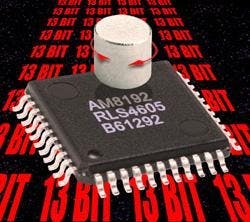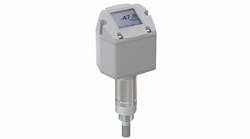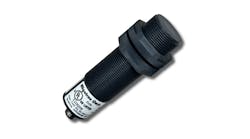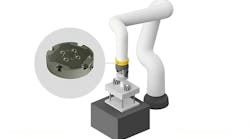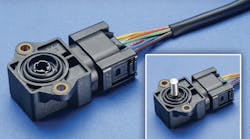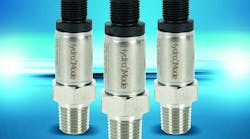world's first 13-bit magnetic rotary sensors — 8192 counts per revolution, low cost, no-wear solid-state reliability
Sept. 26, 2006
Related To: Renishaw Inc.
Renishaw takes non-contact magnetic sensing into new territory with industry's first 13-bit models. One of the world's leading suppliers of position-feedback systems, Renishaw adds the breakthrough 13-bit magnetic sensor to its product family for rotary and angular positioning control. Providing 8192 counts per revolution with ready-for-anything reliability, affordability and application versatility, the new 13-bit sensors are available in chip, chip-on-board, and ready-to-mount packaged versions per standard Renishaw practice. "We try to optimize the ways that advanced magnetic positioning control can be applied to high-speed, precision machinery and systems," said product manager, Howard Salt. Solid-state, non-contact designs – an integrated circuit (IC) chip senses the position of a separate 2 pole permanent magnet — the sensor offers outstanding reliability, packaging efficiency and performance for broad application versatility, said Salt. Especially suited to difficult design and environmental requirements, the magnetic sensors provide –40°C to 125°C operational temperature range and superior shock and vibration resistance. Friction-less low-inertia operation enables consistent, wear-free 0.3° positioning accuracy at high acceleration/deceleration and speeds to 30,000 rpm. The magnetic sensors are developed and manufactured by Renishaw’s partner company RLS Merlina Tehnika, Slovenia, to supply industries worldwide with reliable, high-speed, low-cost rotary positioning technology, particularly for motor control and automation systems. The versatile sensors come in models providing absolute, incremental, analog or digital outputs, even simultaneous SSI and incremental output, said Salt. "Simultaneous capability enables the 13-bit sensors, like all our magnetic product line, to be used for both motor commutation and velocity control at the same time," he pointed out. The rotary magnetic family covers 8, 9, 10, 11, 12 and now 13-bit sensors, all available in chip, chip on board, and packaged/encapsulated versions. “This gives designers everything from 64 ppr to 8192 counts per revolution to fit a wide range of applications,” said Salt. Besides motor feedback and positioning control, he noted, the magnetic products are used for torque sensing, flow control, scanning, and instrumentation, and can be selected for such price-competitive applications as industrial power tools, vending machines, CCTV, and valve positioners. Chip and chip-on-board models allow the sensors to be engineered and integrated into machinery and equipment designs. The ability to operate with a gap between the magnetic actuator and encoder chip meets design needs for isolation of moving elements. The component and modular units allow designers to optimize fit and space efficiency. Packaged versions enclose the chip and electronics in robust metal cases for "fit and forget" reliability that should outlast the productive lifetime of the host machine, stated Salt. Enclosed units are widely used in rugged applications and environments — agricultural, automotive, elevators, converting, printing, metalworking, industrial automation, avionics, and military defense. Sealing to IP68 is available. Fully encapsulated versions are waterproof for wash-down processes and even immersible for use on pumps, marine equipment and sub-sea systems. Two mounting versions are available — with shaft or with a hole for mounting on a shaft. A mounting flange fits typical motor enclosures. Small size, from just 22 mm-diameter body, allows easy fit. Two-part, non-contact design removes the need for seals or bearings, ensuring long-term reliability and simple installation. At the heart of every Renishaw magnetic rotary encoder are two core components — a small diametrically polarized magnet and a custom ASIC which contains an array of Hall effect sensors that generate a voltage when exposed to the magnetic flux field. The ASIC detects the change in magnetic flux density distribution at the surface of the silicon chip as the magnet rotates above it and delivers a voltage representation of magnetic field distribution. Through creative design, the ASIC is able to cancel magnetic interference, permitting it to operate in areas of high external magnetic fields. Sine and cosine voltage outputs from the sensor array vary with magnet position. The sine and cosine signals are converted to absolute angle position within the ASIC. This basic sensing technology is then combined to produce a wide range of output formats. Resolutions up to 13 bit absolute (8192 counts per revolution incremental) are achieved with internal interpolation. Output signals are provided in industry standard absolute, incremental or linear formats. Absolute (SSI) and incremental outputs are available on the same chip for motor commutation and feedback. Absolute position models are available in 8-bit (256 counts per revolution incremental) to 13-bit resolution in parallel or serial data formats, while incremental output options include digital (128 ppr), analog, linear voltage and linear current modes. Supply voltage is either 3.3V, 5V or 24V, depending on encoder/output format. Packaging is SSOP28 or LQFP44 depending again on chip configuration. The linear voltage or current output options can be used in traditional potentiometer applications.
